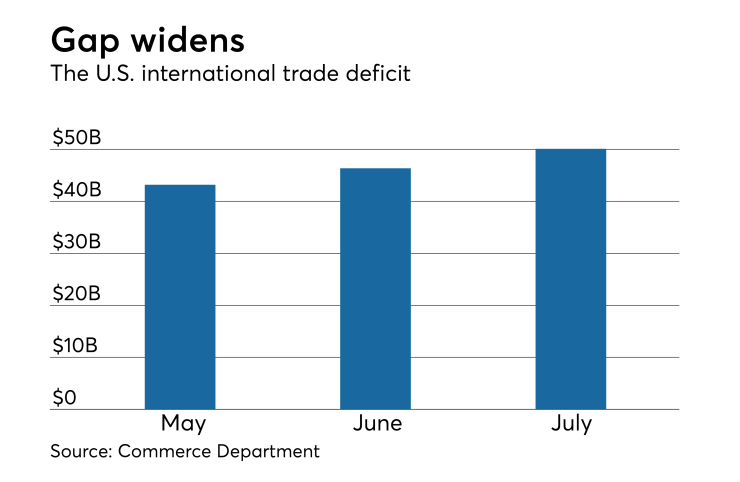WASHINGTON - The U.S. international trade gap widened to $50.1 billion in July from $45.7 billion, a slightly wider gap than the $50.0 billion deficit expected and the largest monthly increase since March 2015, data released by the Commerce Department Wednesday morning showed.
The overall July trade gap was much wider than the second quarter average, as was the census goods gap and the chained trade gap, so if the trade gap does not narrow in August or September, net exports could be a large drag on third quarter growth.

Also of interest, the trade gaps with China and the EU both hit record high levels in July, ammunition for those in favor of further tariffs. The gap with Canada also widened this month, while the gap with Mexico narrowed, but both were wider than a year ago.
The unadjusted bilateral trade gap with China widened to a record high $36.8 billion in July from $33.5 billion in June and $33.6 billion a year ago. At the same time, the gap with the EU widened to a record $17.6 billion from $11.7 billion in June.
The gap with Canada widened to $3.1 billion from $2.0 billion in June, while the gap with Mexico narrowed to $5.5 billion from $7.4 billion.
The revised Census goods gap reported Wednesday was slightly smaller than the advance estimate of $72.2 billion, coming in at $72.0 billion after $67.9 billion in June and a $66.7 billion average in the second quarter.
The overall BOP goods gap widened to $73.1 billion from $68.9 billion in June, while the services surplus narrowed very slightly to $23.1 billion.
The chained goods gap widened to $82.5 billion from $79.3 billion in June, and is larger the $77.5 billion average for the second quarter, a negative factor for third quarter GDP.
The petroleum gap widened to $4.5 billion in July from $4.2 billion in June, with import growth larger than export growth. The nonpetroleum goods gap widened to $67.5 billion from $63.7 billion.
Exports declined in July, with a $0.9 billion fall in foods, feeds, and beverages, a $0.9 billion drop in capital goods ex autos on a $1.6 billion decline in civilian aircraft orders, and a $0.4 billion decline in consumer goods. These were offset by increases in industrial supplies and automotive vehicles, parts, and engines.
Imports increased in July, with a $0.7 billion rise in capital goods ex autos, a $0.5 billion rise in industrial supplies, as well as increases of $0.3 billion and $0.5 billion in foods, feeds, and beverages and automotive vehicles, respectively. These were offset by a $0.8 billion decline in consumer goods imports, specifically pharmaceutical preps.





